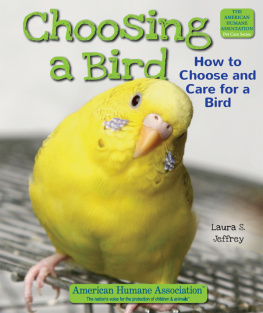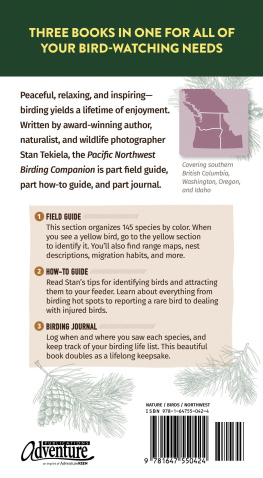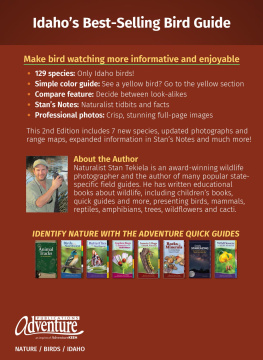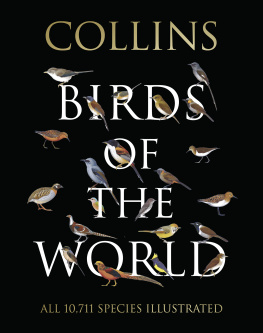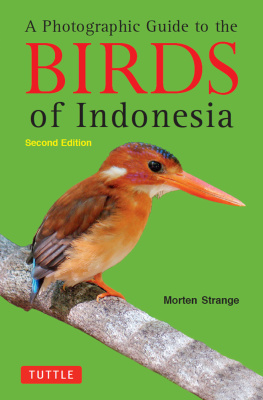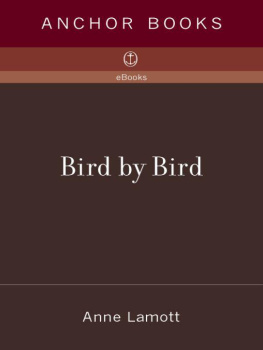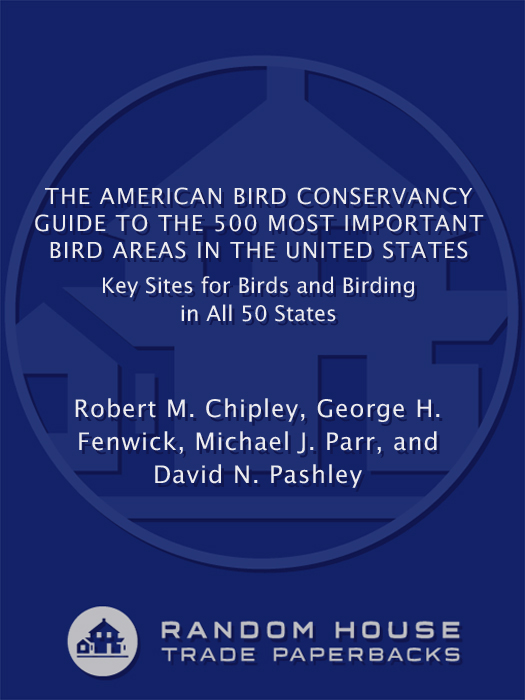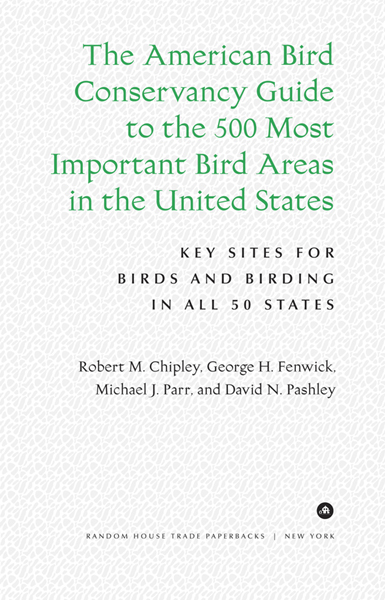
Copyright 2003 by American Bird Conservancy
All rights reserved under International and Pan-American Copyright Conventions. Published in the United States by Random House Trade Paperbacks, an imprint of The Random House Publishing Group, New York, and simultaneously in Canada by Random House of Canada Limited, Toronto.
R ANDOM H OUSE and colophon are registered trademarks of Random House, Inc.
Library of Congress Cataloging-in-Publication Data
The American Bird Conservancy guide to the 500 most important bird areas in the United States : Key sites for birds and birding in all 50 states / by American Bird Conservancy in association with the Nature Conservancy.1st ed.
p. cm.
eISBN: 978-0-307-48138-2
1. Birding sitesUnited States. 2. Birds, Protection ofUnited States.
3. Endangered speciesUnited States. I. American Bird Conservancy.
II. Nature Conservancy (U.S.)
QL682.A54 2003
598.0723473dc21 2003043229
Random House website address: www.atrandom.com
v3.1
FOREWORD
SAVE THE BIRDS, SAVE OURSELVES
Paul R. Ehrlich
Why should we care about the conservation of birds? Ornithologists and ecologists can readily rattle off reasons why we should care ranging from the importance of birds in supplying ecosystem servicescontrolling insects and rodents, dispersing seed, and pollinating plantsto their value as indicators of environmental health.
Less frequently cited is the role birds have played in affecting human culture: birds live in every ecosystem on Earth, have been present at the rise and the fall of every human civilization, large and small, and have had profound effects on our species throughout our history. Neolithic people scratched migrating geese on cave walls, and Egyptians carved falcons on kings thrones. Quetzals adorn Mayan temples, and pictures of birds can be found in most American homes today. The reason for this extraordinary use of bird images cannot be traced to their ecological roles but most likely originated in their effects on the human spirit.
Cranes, parrots, corvids, and even sparrows permeate human history, cultures, and religions. Eagles and falcons have long been used to symbolize national power, and doves represent peace. In times of trouble, bird songs soothe our spirits. Storks deliver us at birth, and owls mourn our deaths. The migration of birdsonce thought a mysterious annual disappearance, perhaps into the depths of the seahas exemplified human wonderment and the quest for knowledge. And many of us revel in the vivid colors and fascinating behavior of birds and, in the process, imagine ourselves close to nature.
But in truth we are growing apart from nature. Our own species now dominates the biosphere and is increasingly destroying it. Growing human populations, increasing per-capita consumption (especially among the rich), and the selection of environmentally unfriendly technologies and institutions are sawing off the limb on which humanity is perched. Most people seem to be unaware of the seriousness of the destruction and unable to perceive the message of danger being sent by our avifauna. But we should not be: while only a few North American species have disappeared, many bird populations have undoubtedly gone extinct, often unheralded. The Whooping Crane, Eskimo Curlew, Spotted Owl, both Prairie-Chickens, Yellow-billed Cuckoo in California, Red-cockaded Woodpecker, Kirtlands Warbler, and Seaside Sparrow are among the better-publicized examples of extensive population loss. Fully 70 percent of eastern neotropical migrants have dwindled in numbers in the past 20 years. Seven of 12 species endemic to the Great Plains grasslands have declined in the past 25 years. In the West, the Marbled Murrelet and California Gnatcatcher have created concern as species threatened by habitat loss leading to population extinctions. Even though we should be very concerned about species loss, it is populations that supply ecosystem servicesincluding the esthetic and life-enriching services birders value so much.
Outside our borders things are often worse. Almost 300 species are threatened with extinction in the American tropics, and untold populations throughout the developing world are being extirpated as forests and swamps are cleared for grazing, agriculture, silviculture, and aquaculture.
These losses are damaging not just in terms of the environmental services birds providethough these are substantialbut because of what they say about our cultures and our values today. Birds and their habitats are in decline almost everywhere, and, increasingly, people choose just to look the other way. The generosity of our spirit has diminished to the point where we seem no longer willing to find room for these beautiful and interesting representatives of Earths disappearing biota. We are heedlessly wiping out a substantial portion of our only known living companions in the universe.
We stand today at a crossroads: Never has the rate of loss of biodiversity been greater during the six million years of human historyand the engine of destruction is Homo sapiens. Never has our species been more disconnected from the natural world; but, ironically, never have so many Americans been interested in the welfare of birds. Yet never has a nation had greater financial capacity to provide for nature, and never before has humanity had so much scientific capacity both to understand and protect birds.
Those who care about conservation recognize that the future of our species depends on the future of the other life on our planetfor ecological, economic, and spiritual reasons. There is also a growing awareness that our ability to turn our own species onto a course that allows for the continued sustenance of all life will require reengaging people with nature and a reacquisition of humanitys appreciation for the life around it. Birdsomnipresent, beautiful, and mysteriouscan be natures best ambassadors.
Birds, like all other organisms, face two basic kinds of threats: those that reduce reproduction and those that increase mortality. Factors affecting mortality are legion, ranging from bycatch of seabirds in the worlds commercial fisheries and the widespread use of pesticides and other toxic chemicals to the introduction of alien predators and the construction of lighted towers and buildings that attract migrants to their deaths. Reproduction is also affected by many things, but none more significant than the galloping loss of high-quality habitat. Not only is habitat absolutely lost via permanent alteration of the landscape to suburban development, row crop agriculture, and so forth, but more is lost to fragmentation and degradation, invasions of exotic plant species, and land management not conducive to wildlife. Global climate change is likely to exacerbate habitat loss, since natural processes of adjustment could be overwhelmed by unprecedented rates of change, and organisms will certainly face human-created barriers to movement.
Many people believe habitat loss to be the greatest threat to all wildlife, and myriad efforts are underway to stem the tide of these lossesto some effect. Led by broad coalitions such as Partners in Flight (more than 300 groups cooperating for the conservation of bird habitat) and the North American Bird Conservation Initiative (collaborative planning and conservation among the major bird initiatives for waterfowl, shorebirds, raptors, and songbirds), ornithologists have become highly organized in the past decade in targeting conservation of prime breeding, wintering, and migratory areas.



